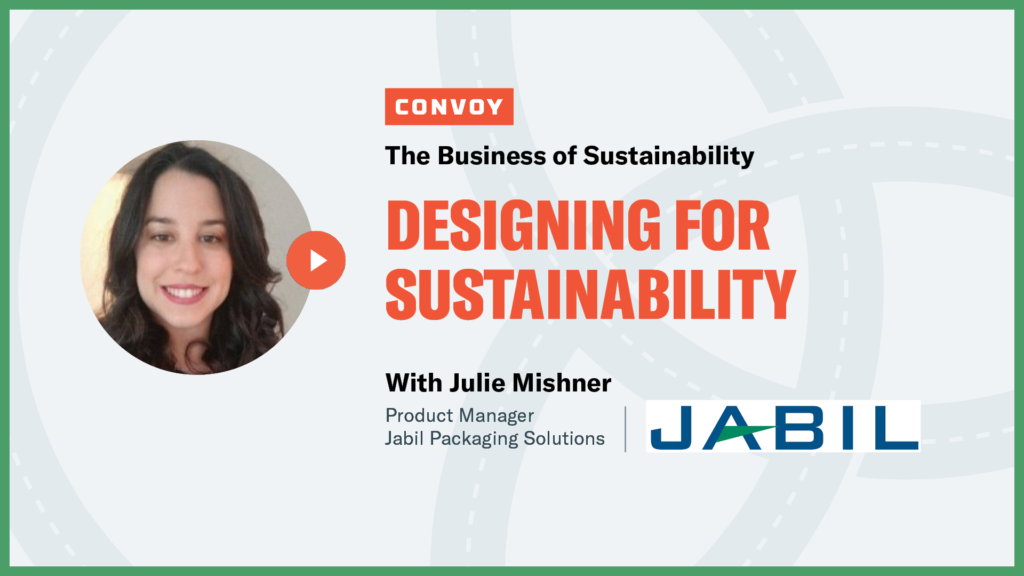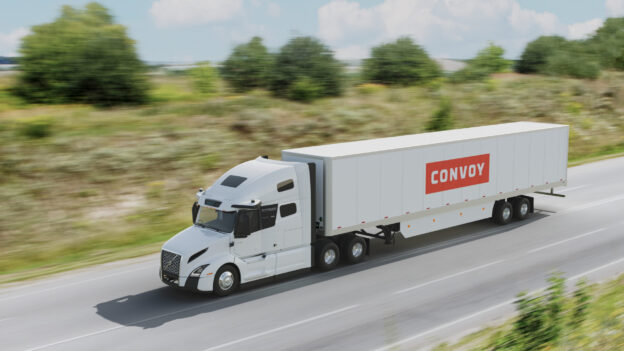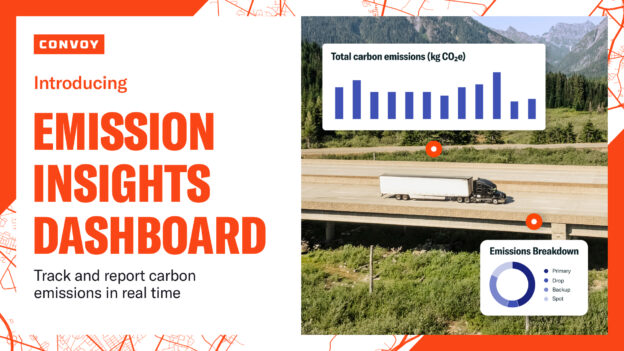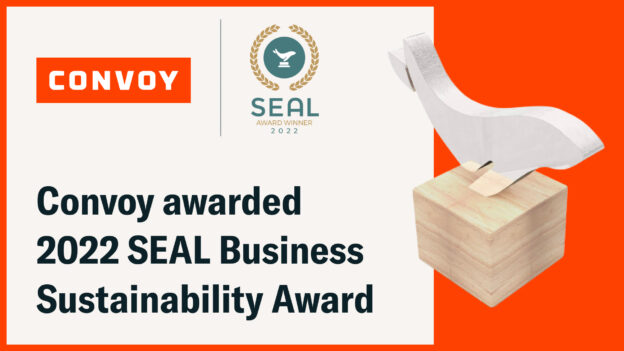Designing For Sustainability With Jabil’s Julie Mishner
Sustainability • Published on April 27, 2021
Designing products always involves a plethora of specific requirements and restrictions, but perhaps nothing is quite as challenging as when you are tasked with reinventing existing products with the specific challenge of making them more sustainable. With everything from water bottles to single-serve coffee pods, imagine that your customers don’t need you to reinvent the wheel — they just need that wheel to become more sustainable than it was before.
Julie Mishner, Product Manager at Jabil Packaging Solutions, a global manufacturing solutions provider, joins us today for our Business of Sustainability series. Jabil produces everything from printed circuit boards to product packaging and is a $27 billion organization with a global presence across North America, Europe, and Asia.

Julie invites us into her world of food product packaging — which is her primary purview at Jabil — and shares what drives Jabil’s initiatives as well as the exciting trends she is seeing for 2021. Watch the video above or follow along with the summary of her viewpoints below.
- How Jabil Sees Value In Sustainability: The question is how do you put a value or a price tag on being more environmentally responsible? The answer is that you can’t. For Jabil Packaging Solutions, being sustainable is more of an imperative and integral part of our strategy moving forward. If we’re not providing a sustainable improvement to an existing product that is already out there which solves a problem, our customers aren’t interested. The value for us is being more responsible throughout the entire life cycle of a product. Sometimes that means redesigning the package so it ships less and saves on freight. Any time we can see an improvement throughout the lifecycle, that’s a value add for Jabil. (2:02)
- The Trend In More Space Efficient Packaging: A big trend is the cubitization of products in order to have more efficient packaging. Even with eCommerce, it is imperative to fit more in a box to ship to your customers. It is an entirely new problem that our customers have to solve. (3:50)
- How The Increase In Customer Demand Drives Sustainability: The increase in customer demand for sustainability is having revenue impact. Nobody can solve this problem alone, so we’re partnering with our customers and our suppliers. The relationships we are developing across the supply chain are huge and feel like nothing we’ve done before. We are currently developing new material compounds which are home compostable for our customers. This is not something I thought I would have seen us do five years ago. (4:30)
- Determining Which Sustainability Initiatives To Focus On: One of the biggest drivers is legislation. We have a lot of customers in the EU, and there’s an EU directive that is targeted at single-use plastics, so one of their initiatives and one of our initiatives is solving the tethered closure for our customers. Right now, if you take a water bottle, the cap just comes off and most people don’t even know if you leave the cap on or take it off. One of the things that is very important to ask from the start is to develop a tethered closure which is essentially, like, keeping the closure on the bottle after use. Then the second part involves us asking “what is the biggest problem our customers are trying to solve?” As an example, with the home compostable material we are working on, the goal is to address single-serve coffee capsules, which are a huge problem. Everyone out there listening is very familiar with the big piles of waste that are the single-serve coffee capsules. Coffee is actually an ideal compost feedstock. Current solutions include making it recyclable or using recyclable materials. Or you can also make it compostable. If you can make the package compostable, then it’s a win-win. (5:34)
- How Sustainability Shows Up Across Jabil: We have a huge environmental health and sustainability division. It’s hugely important to our company and, of course, as a publicly traded company, you can view our sustainability report online. But from a technology standpoint, I have seen some of my colleagues implement these huge initiatives to prevent e-waste (electronics). Jabil is largely an electronics manufacturing company, so preventing e-waste and even extracting metals from e-waste and also using alternative materials for durable electronics is key. (08:54)
- The Sustainability Trend She Is Looking Forward To The Most This Year: There are a few. Definitely in terms of plastics, biobased polymers for renewable resources is really interesting. These are just polypropylene, polyethylene renewable resources, not from fossil fuels. They act and function and look exactly like the fossil-based resin. Additionally, food-grade PCR, which is the post-consumer recycled resin. It’s really tricky and difficult to get because recyclability is not high. There is already a low capacity of recycled resins out there and then even lower capacity that is FDA contact approved. You’re essentially asking people to put reprocessed garbage into their food packaging. So, it’s clean and like new and can be used in upcycling applications as opposed to downcycling. And then another really exciting initiative is we just acquired a company called Ecologic Brands. The shell of this beverage bottle is made out of recycled cardboard and it can be separated and then the amount of plastic needed inside is greatly reduced. It enables you to use significantly less plastic because you don’t need to rely on it for the structure. You can separate the components and each product is completely recyclable offering huge plastic reductions. To me, those are the most exciting trends in my world for sustainability. (10:18)
TRANSCRIPTION
Jennifer: Can you tell me more about your role and responsibilities as a product manager at Jabil?
Julie: Sure, yeah. So, you did a really good job of introducing Jabil as a massive company. It’s a 27-billion-dollar global organization that has presence across the world, North America, Europe, and Asia. We manufacture everything from printed circuit boards all the way to plastic packaging. Which brings me to my role, is the food and beverage product manager in the Jabil Packaging Solutions Division. So, my roles and responsibilities really include taking trends and needs from the market and from our customers, which happen to be, you know, some of the biggest consumer packaged goods companies, and taking them and developing real solutions that solve their problems and help them stay relevant. So as the product manager, my responsibilities are to oversee the full life cycle of the product all the way from concept all the way to commercialization.
Jennifer: That’s incredible. So, I love that the company has a role like yours where you’re really taking in trends and customer feedback to really develop new and innovative solutions for your customers. So how does Jabil see the value of sustainability? [2:00]
Julie: So, I love this question because I think that I could take all day to answer it. And, you know, the value is huge, right. So, the question is how do you put a value or a price tag on being more environmentally responsible and the answer is that you can’t. So, I think for Jabil Packaging Solutions, being sustainable is more of an imperative and integral part of our strategy moving forward. So, if we’re not providing a sustainable improvement to an existing product that is already out there that solves a problem, our customers aren’t even interested. Right? Its kind of like a nonstarter for a conversation. So, for us, I mean, the value, it’s really being more responsible throughout the entire life cycle of a product and sometimes that even means redesigning the package so it ships less and saves on freight, you know, for example, you can take a, you know, like a container that nests into one another and that can save, you know, that can…just redesigning that and making nestable containers, that saves on freight. So, I would say any time that we can see an improvement throughout the lifecycle, like, you know, that’s a value add for us.
Jennifer: That’s great. When you mention kind of what more space efficient packaging…the one thing that is so memorable for me, this is probably 10 years ago, but its when milk cartons became square instead of the classic milk jug look, they become very square because more efficient to package together and ship to all these locations and that’s the one thing that stands out in my mind.
Julie: And that’s a big trend. I guess, like, cubitization, right, of products and having, like, more packaging efficient and its even, like, its even important now [4:00] as like for eCommerce, you can fit more in a box that you ship to your, like, to your customers. Its an entirely new problem that our customers have to solve.
Jennifer: Yeah, that’s great. Well, since you mention that sustainable…its hard to find a tangible or quantifiable metric to understand the value. Could you share an example of a specific result or impact that sustainability has driven for the business?
Julie: Sure, I don’t know how specific it is but one really, I mean, so of course there’s an increase in customer demand, right? So, we’re seeing revenue impact. But it’s also really important for us, like the results that we’re seeing, is that…the problem is that nobody can solve this problem alone, right? So, we’re partnering with our customers and our suppliers and the relationships that we’re developing across the supply chain are huge and really feels like nothing we’ve done before. So, I can think of one example that’s come out of this. And we’re even developing, we’re developing new material compounds that are home compostable for our customers. Which I think is really kind of, it’s not something that I think that I would have seen us done 5 years ago.
Jennifer: That’s awesome to see. I can’t wait to see it in my own homes sometime soon. So, when you mention a project like this, huge undertaking when you’re really kind of reinventing the whole product life cycle, how do you determine what sustainability initiatives to focus on?
Julie: Sure. I would say it’s kind of two-fold, I guess. One of the biggest drivers is going to be driven by legislation. So, we have a lot of customers, our customers in the EU, there’s an EU directive that is targeted at single use plastics so one of their initiatives I guess, and one of our initiatives is solving the tethered closure for our customers. [6:00] And right now, like if you take a water bottle, you know, like the cap just comes off and most people don’t even know if you leave the cap on or take it off. For the record, we leave it on. So, one of the things that is very important to ask from the start is to develop a tethered closure which is essentially, like, keeping the closure on the bottle, like as after use. So that’s one part of it. And then the second part of it is, like, what problems, what’s our biggest problems that our customers are trying to solve? So, I mentioned the home compostable material that we’re working on, that’s really for coffee, like single serve capsules, which is a huge problem. I’m sure everyone out there listening is very familiar with, you know, like the big piles of waste that are coffee capsules, the single serve coffee capsules.
Jennifer: I have one of those machines at home.
Julie: So, I’m sure you’ve seen them pile up in your trashcan and kind of feel guilty about it. Or maybe you don’t, I don’t’ know. But coffee is actually, it’s an ideal compost feedstock. So, current solutions, like, one is you can make it recyclable, or well, I guess you can’t, well, yeah, you can use like recyclable materials, I guess. And then also you can make it compostable. So, either you have the recyclable, you can make it recyclable or, sorry, you make it recyclable, or it goes to the landfill. Right? And either way, your coffee is wasted, right? You’ve got valuable compost feedstock that is going to waste. So, if you can make the package compostable, then its kind of like a win-win, right? The package disappears, it composts, and you get to use that coffee, [8:00] you actually get to use it as compost in your compost. So that’s an innovation that has come from like a very real need with not a lot of obvious low hanging fruit solutions out there.
Jennifer: I see. Thanks for sharing that example. I do think about it every morning when I use my machine. There are these pods that pile up over time. Like, you don’t really notice it but when I do reordering and get my box of 100, like wow, this is a lot of stuff that I’m eventually, like, tossing away. Yeah. Thanks for sharing that example. So, just have a couple other questions for you as well. You mention that Jabil is a huge, multi-national company, how does sustainability show up across the entire organization? How is it integrated across departments?
Julie? That’s also a huge question. There’s just one person in Laban, Durham, North Carolina. But we do have a huge sustainability, right, the environmental health and sustainability division. Its hugely important to our company and of course, as a public company, publicly traded company, you can view our sustainability report online and download that. But from a technology standpoint which I think is even, like, more interesting to me, I have seen some of my colleagues have these huge initiatives to prevent e-waste. So, electronics, Jabil is largely an electronics manufacturing company. So, preventing e-waste and even extracting metals from e-waste and also using alternative materials for durable electronics. Which is like alternative plastics and alternative resins for durable electronics which is a little bit of a different story, right, from your everyday [10:00] plastic packaging.
Jennifer: Awesome. Well just one last question for you Julie and thank you so much for your time today. So, you mentioned a part of your role is looking out for sustainability trends, what sustainability trend are you most looking forward to this upcoming year?
Julie: There’s a few. Like, definitely in terms of plastics, biobased polymers for renewable resources is really interesting and these are, you know, like just polypropylene, polyethylene renewable resources, you know, like not from fossil fuels which I think is super interesting. And they act and function and look exactly like the fossil fuel, the fossil-based resin. And then, food grade PCR which is the post-consumer recycle resin. Its really tricky and difficult to get because as people have probably seen in the news, recyclability is not super high. So, there is already a low capacity of recycled resins that’s out there and then even lower capacity that is, you know, like FDA approved contact. You’re essentially asking people to put, like, reprocessed garbage into their food packaging. So, there is some processes that take that resin, or that recycled resin and they process it and chemically, chemical recycling and they process it and return it to an almost virgin like polymer state. So, it’s clean and its, you know, it’s like new and it can be used in upcycling applications as opposed to downcycling which is like, kind of, you know, like in a deck material, even clothes [12:00] is considered downsizing like when you reuse bottles in clothes and stuff like that. So that’s really exciting. And then another really exciting that I have to just plug a little bit, is we just acquired a company called Ecologic Brands. And it’s really awesome because…I brought a little sample with me.
Jennifer: Let’s see this. Is it made out of some sort of compostable material? Looks like paper.
Julie: So, it’s actually made out of recycled…so the shell is made out of recycled cardboard and it is…it can be separated. I don’t want to separate this one because I don’t want to ruin it, one of my samples. But I do have here…it can be separated from each other and then the amount of plastic is super, like, greatly reduced, right. I can’t remember the exact percentage but you’re using significantly less plastic because you don’t need to rely on it for the structure. And I’m sure you’ve seen like water bottles that feel like they’re almost plastic bags.
Jennifer: Yeah.
Julie: So, it’s almost like that but like, you know, a better use and a better feel.
Jennifer: That’s exciting. I love that idea.
Julie: Yeah, its really nice. You can separate the components. Fully recyclable, like, each product is completely recyclable and huge plastic reductions. So, to me, those are the three most exciting trends in my world for sustainability.



